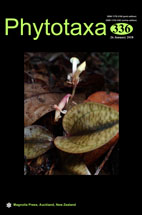Abstract
Diaporthe sambucusii sp. nov and D. schisandrae sp. nov., collected from diseased branches of Traditional Chinese Medicine in Northeast China, Sambucus williamsii Hance and Schisandra chinensis (Turcz.) Baill, are herein described and illustrated. Recognition of the two new species are supported by both holomorphic morphology and phylogenetic analysis. Morphologically, D. sambucusii is distinguished by hyaline, aseptate, smooth, ovoid to subfusiform, biguttulate alpha conidia (7.0–9.5 × 2.0−2.5 μm) and beta conidia hyaline, aseptate, straight to hamate, 18.5–23.5 × 0.9–1.1 μm, similar to most species of Diaporthe. Diaporthe schisandrae is characterized by hyaline, aseptate, ellipsoidal to fusoid, somewhat tubercular at one end and obtuse at other, 1–3-guttulate alpha conidia (8.5–11.5 × 2.7−3.3 μm). Phylogenetic analysis using CAL, HIS, ITS, TEF1-α, and TUB molecular data shows that the isolates of the new species form two distinct clade within Diaporthe (MP/ML/BI=100/100/1).

